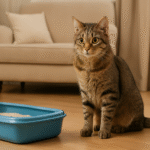When your favorite feline starts moving a little less freely, you might dismiss it as just getting old. But those hesitations to leap or reluctance to make the daily rounds might not be typical aging. Arthritis in cats, though common, stands as a widely underdiagnosed condition. It’s heartbreaking to witness, and that’s why understanding this ailment matters so much. Recognizing signs early can improve your kitty’s quality of life significantly. Understanding arthritis means understanding your cat’s pain, and who wouldn’t want to ease their beloved pet’s suffering?
Arthritis doesn’t just surface overnight. It’s a slow, insidious creep that begins to gnaw at your pet’s joints. Imagine if your once agile cat starts showing signs of stiffness, an unwillingness to jump, or sleeps more than usual. These signs aren’t just quirks—they’re cries for help. Your furry friend might endure quiet suffering, hoping you’ll notice. Forewarned is forearmed. Take action before arthritis takes the joy out of your cat’s graceful moves and playful swats.
So, what exactly triggers this debilitating condition in cats? Several culprits exist. Overweight felines have a higher disposition, as extra pounds strain their joints. Just like us, high-impact activities can wear out cartilage over time. And while genetics play a part, environmental factors compound these issues. Keep an eye on changes around the household. Move any furniture recently? Introduced a new pet? Even seemingly irrelevant tweaks to your cat’s environment can contribute. Understanding these variables can help mitigate the symptoms and ease the galore pains.
Diagnosing arthritis early means fewer days spent in discomfort. When you bring Mittens to the vet, a few investigative steps kick in. Careful observation, physical examinations, and sometimes x-rays or other imaging modalities help build the complete picture. Advocate for your pet, asking questions and voicing concerns. Don’t shy away from a second opinion if needed. You hold the key to translating Mittens’ silent struggle into a verbal one. It’s okay to clamor for answers; after all, you’re shaping your cat’s future well-being.
Once you confirm arthritis, treatment options burst open like a floodgate. Veterinarians can recommend various approaches depending on the severity. Some solutions are deceptively simple, like incorporating more omega-3s or ensuring a steady exercise regimen. Others, like prescribed anti-inflammatory medications, require professional oversight. Natural supplements such as glucosamine or chondroitin may also help cushion the joints. Each cat is unique, so tailor the bespoke treatment plan with your vet’s expert guidance.
Support your furry muse by making their living space arthritis-friendly. Consider soft, accessible bedding that reduces the stress on achy joints. Elevated feeding stations or non-slip mats grant them stability during meals and meandering. The point isn’t to spoil but to soothe, turning everyday activities into less of a chore. This focus on comfort doesn’t mean wrapping your cat in bubble wrap; it’s about removing unnecessary obstacles. Transform the burden of arthritis into a light breeze that blows through the household with ease.
Your emotional bond with your feline friend serves as their beacon of trust. Lean into that relationship, tuning into not just the physical but emotional and psychological nuances of their behavior. Building a supportive community is incredibly valuable. Forge connections with other cat owners who might be going through the same journey. Share tips, exchange stories, or even decompress over shared concerns. Relieving arthritis doesn’t rest on medication alone; it thrives on a network of love, care, and solidarity.
Diet and Nutrition: Fueling your Cat’s Joints
Food often holds the key to balancing health. For cats with arthritis, diet plays a crucial role in managing symptoms. The right nutrients can fortify the body against the inevitable wear and tear. Remember, the essence of healing begins from within, and a balanced diet can act as the frontline soldier in the battle against arthritis. Why not treat your cat’s meals as the foundation for enduring health?
Proteins often function as building blocks for muscles and should form the core of a cat’s diet. Quality matters, and ensuring high-quality protein sources can assist in maintaining muscle mass that supports the joints. Seek foods rich in amino acids, which act as lubricants and muscle-repair agents. It’s akin to oiling a rusty machine, ensuring each cog turns with grace and precision.
Managing weight becomes paramount as excess pounds place unneeded stress on already tender joints.
Misdirected indulgences like too many treats derail efforts and propagate discomfort. Opt for low-calorie treats or use interactive toys to combine playtime and exercise. Consider a shift to weight-management formulas specifically designed to keep your feline in ideal shape. It’s a proactive stance against a stealthy adversary.
Omega-3 fatty acids emerge as a treasured ally in this dietary warfare. With their anti-inflammatory properties, they offer the soothing relief that arthritic joints crave. Incorporate fish oil supplements or choose feline foods enriched with these fatty acids. It’s like applying a balm that works from the inside out, offering joint relief time and again.
Hydration, while often underestimated, deserves your attention too. Water facilitates cartilage function and joint lubrication. Offer fresh water frequently and consider wet food options to increase intake. Ensuring that your cat stays hydrated mirrors nurturing a garden—watching it flourish and grow stronger each day. Proper nutrition is transformative, an unseen force unlocking doors to health and happiness.
Exercising with Arthritis: Encouraging Safe Movement
No couch potatoes here—your feline needs motion to prevent joints from locking up. Structured, thoughtful movement keeps those aches at bay. You shouldn’t curb exercise completely, just adapt it. The goal isn’t just activity but ensuring it happens safely without added strain.
Short, gentle play sessions become the order of the day. Utilize toys that mimic prey, not only engaging them but encouraging instinctual movements. These toys act like pivots, initiating natural movement without overstressing those fragile joints. Laser pointers work wonders by offering tantalizing spots to chase without taxing contact.
Low-impact exercises, such as walking, yield fantastic benefits too. Consider creating a mini obstacle course using steps or cushions to gradually build flexibility and strength. Small leaps on low objects reinforce muscle tone and improve joint stability. Exercise becomes not only a necessity but a delightful bonding opportunity, swinging the doors of interaction wide open.
Encourage exploration around the home, possibly integrating cat shelves or climbing structures accessible via gentle ramps. That way, the temptations of height don’t come with penalties of pain. Handcrafted environments await discovery, stretching both their bodies and imaginations without overburdening them.
Consistency remains your strategy’s backbone. Build a routine your cat can anticipate and appreciate, both physically and mentally. Whether it’s morning stretches or evening strolls, once a pattern establishes, both you and your pet will benefit from routine movements. Let your cat relish the gift of mobility, achieved with care, consideration, and loving dedication.
Pain Management: Strategies Beyond Medication
Here’s a fact: medications alone don’t constitute an entire treatment plan for arthritis in cats. Thrilling innovations in pain management open new paths paved with hope. Embrace the arsenal of alternative therapies available and redefine how you address your pet’s pain.
A natural first step involves acupuncture, an ancient practice revitalized by modern science. It targets specific pressure points, relieving pain and swelling as techniques restore balance. Cats often respond well, feeling less stressed during and after sessions. Consider weaving acupuncture into the holistic plan, adding a novel dimension to treatment.
Laser therapy offers non-invasive relief through concentrated light that penetrates deeply, stimulating cells, reducing inflammation, and providing relief from discomfort. It’s akin to a warm, reassuring embrace, harnessing technology to deliver a calming effect on affected areas. Schedule regular sessions and embark on a journey toward sustained comfort.
Physical therapy also joins this lineup, provided with guidance from trained professionals. Activities like swimming support weight naturally, reducing pressure and enhancing flexibility without confronting fragile joints head-on. Imagine the grace of fluid movements and the gentle resistance building strength without pain.
Environmental enrichment through aromatherapy holds surprising potential. Calming scents can reduce stress, improving overall wellbeing. Essential oils safely diffused into shared spaces work wonders for relaxation. The atmosphere evolves, tapping into a sensory experience that resonates profoundly with both cat and owner alike.
Creating an Arthritis-Friendly Environment
The environment where your cat spends their daily life can either contribute to or alleviate their arthritic condition. With some creativity, you can transform their habitat into a sanctuary of comfort. Remember, every leap, jump, and stroll can either be a new start or a reminder of pain.
Start by considering easier access to their favorite hangouts. Replace steep stairs with ramps and ensure comfy bedding stays within easy reach. This thoughtful transition eliminates barriers while retaining familiarity, offering simple solutions that have monumental impacts.
Carpeted areas or rugs offer a dual benefit: soft landings plus traction. Cats relish surfaces where they don’t slip, allowing confidence in every tentative step. It presents a faux savannah, where your cat can roam with grace and poise, unafraid of losing footing.
Consider heated pads during the colder months; they offer warmth that soothes aching joints, nurturing relaxation points. With temperature set just right, shared moments of peace beckon, comforting the heart and assuaging weary muscles.
No elder cat’s setup should be without easily accessible rest areas. Elevated beds tackle swelling by keeping legs elevated without demanding the energy to jump. Providing these plush repose spots offers relief in repose, like reclining royalty, where each rest rejuvenates the soul.
Toys that tantalize without taxing provide perfect play as well. Think of balls that roll with ease, feathered enticements that float and dart, excitable but forgiving. Encourage playtime that prioritizes fun, which in turn becomes natural therapy. Your DIY haven, lovingly pieced together, will become their best friend, one that makes arthritis merely a footnote in an otherwise joyful narrative.


